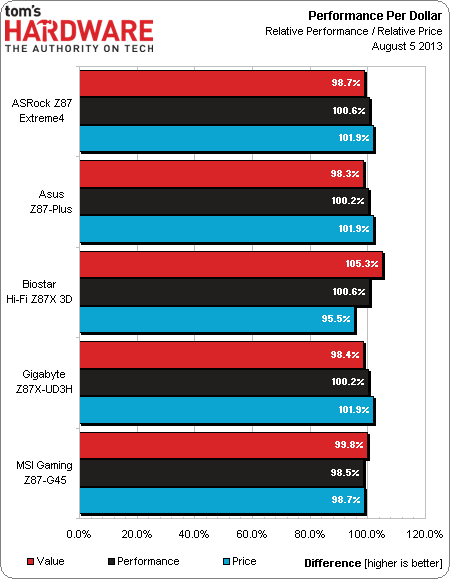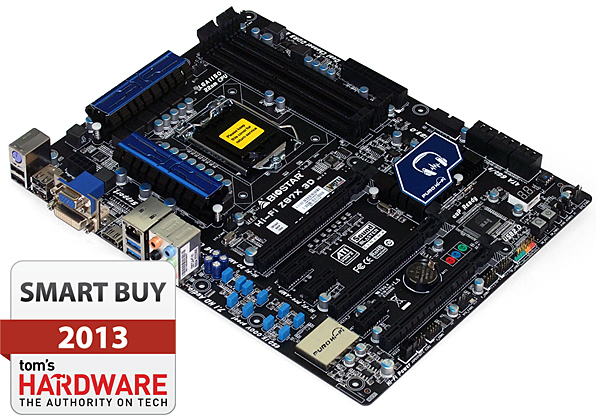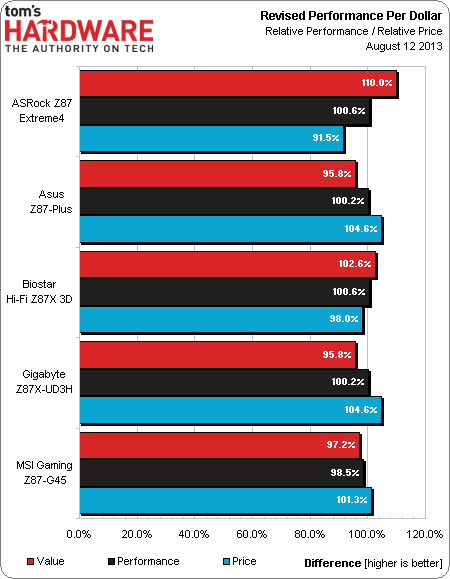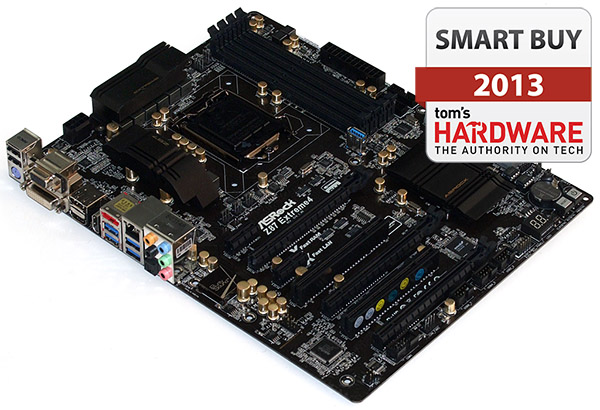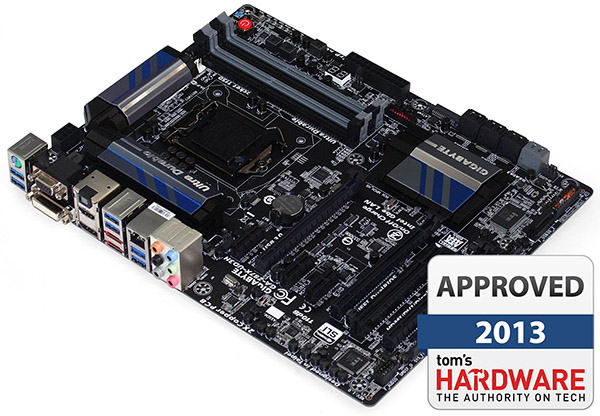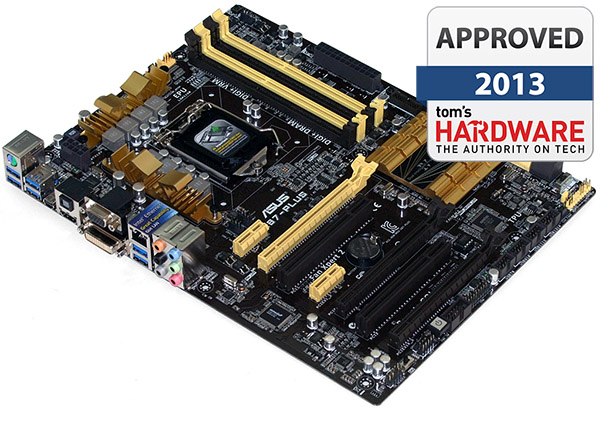Fast And Cheap? Five Sub-$160 Z87 Motherboards For Enthusiasts
Intel’s Haswell architecture has mainstream leanings. And yet some of the motherboards out there are really high-end. Today we're looking at five platforms under the $160 mark that hopefully put some value back into being an enthusiast.
When Picking A Winner Is Almost Impossible
Why you can trust Tom's Hardware
Four out of five motherboards in today’s review were top CPU overclockers. Though it means less to overall system performance, two of those boards were also top DRAM overclockers. That tie goes to Asus' Z87-Plus and Biostar's Hi-Fi Z87X 3D.
In this day in age, performance differences directly attributable to the motherboard are tiny. Often, we see vendors juicing their BCLK frequencies by a touch here in there for the slightest advantage. We've called this cheating in the past. However, when we compared relative performance to relative price on August 5th, the above chart is what we end up with.
Biostar's Hi-Fi Z87X 3D is at the top. On the 5th, it was also the cheapest board in our round-up. And yet it hung in there with the rest of the pack in terms of overclocking. This platform is light on value-added extras; however, it handles the basics well. As such, it rose to the surface as the original pick for our Smart Buy award. This is a Tom's Hardware recognition that explicitly calls out bang for your buck, and it's well-deserved.
Comparison shoppers might point out that for $5 more, MSI’s Z87-G45 Gaming offers an improved audio codec, a high-end network controller, and an mSATA slot. We did see a few very tiny performance deficits, though. More important, the board came up a little short in overclocking, where we expected it to stretch 100 MHz higher. In a story where several platforms win something, coming up short in overclocking is what stopped us short from adding the Z87-G45 to our list. Instead, we had to consider what another $5 might buy.
Back on the 5th, three motherboards were in the $160 range, all equipped with high-end features, adding a third-party controller for additional SATA connectivity and hubs for USB 3.0 ports. Of the trio, ASRock's Z87 Extreme4 has the best audio implementation, while Asus' Z87-Plus achieves top honors in DRAM overclocking. ASRock also has the ability to split three PCI Express x16 slots into x8-x4-x4 if you really want to run a trio of Radeon cards in CrossFire. Just be aware that any other card you drop into the third slot will take bandwidth away from the graphics subsystem.
The Asus and Gigabyte boards also have third x16 slots, but they take their lanes from Intel's Z87 Express Platform Controller Hub. The Z87-Plus only wires up two second-gen lanes to its third slot, while Gigabyte connects four. To get there, Gigabyte disables two of its x1 slots. Both sacrifices are a little tough for me to accept, but we can only look to Intel for designing yet another PCH with eight PCI Express 2.0-capable lanes for expansion. Asus adds USB BIOS Flashback, a feature that proves most valuable on long-life platforms like Socket AM3. Gigabyte adds a Port 80 diagnostics display that comes in useful when you're setting up an overclock (though it might also help diagnose a failed component). The two companies have exceptional reputations in the industry, and they've spent many years developing compelling supporting software.
Those considerations opened us up to a three-way tie at the top of this round-up's price range. However, as it tends to do, ASRock cut a $20 discount with Newegg, dropping the price of its Z87 Extreme4 to $140. Whereas we were hesitant to recognize all three boards selling at $160, the Z87 Extreme4's discount was the tie breaker. Here's how our value chart appears today:
We don't like giving out awards based on temporary discounts since our logo shows up on packaging long after prices go back up, and moving forward, we're taking steps that should prevent any vendor from playing pricing games. Until the next round-up, though, it'd be impossible for us to deny that ASRock's Z87 Extreme4 is an impressive buy for the amount of hardware you get at $140. In this case, you, the reader, win. ASRock earns recognition parallel to Biostar as a result.
This isn't to take away anything from the two boards still selling around $160: Asus' Z87-Plus and Gigabyte's Z87X-UD3H. We suspect both are truly worth more than the price at which they're selling, and wouldn't hesitate to recommend either to an enthusiast able to put their feature sets to good use. So, in an unprecedented move for us, we're acknowledging both platforms with Tom's Hardware Approved recognition.
One thing we will add: ASRock's Z87 Extreme4 is worth its more prestigious award as long as it's notably cheaper than the Z87-Plus and Z87X-UD3H. We're holding ASRock responsible for maintaining the lower price it just set into place, and we're asking you to help. The free market is dynamic, and prices do fluctuate. But if you can't find the Z87 Extreme4 in stock within 10% of $140, let us know before our next round-up. We're here to be your advocates, after all.
Current page: When Picking A Winner Is Almost Impossible
Prev Page OverclockingGet Tom's Hardware's best news and in-depth reviews, straight to your inbox.
-
InvalidError The sad things about "exposing enthusiast features" on z87:Reply
1- the x8x4x4 PCIe controller is a CPU feature in all i5 and i7. All the z*7 chipset does is unlock the CPU feature
2- same goes for multipliers on K-chips: CPU feature locked out by non-z*7 chipsets
3- SATA-6G ports do not really cost Intel any thing extra to put on-chip (little more than a PLL tweak to lock on faster signals), which makes it somewhat of a shame they aren't fully standard
4- USB3 ports do not cost Intel all that much extra either - maybe an extra square millimeter on silicon to upgrade all remaining USB2 ports to USB3
5- the DMI bus can only manage ~20Gbps so it will bottleneck if you attempt to use even 1/5th the total the connectivity available on z87
More connectivity, yes. But DMI lacks the muscle to actually stress that extra IO. As such, it is little more than a glorified SATA port replicator and USB hub.
I almost exclusively use Intel CPUs but it still annoys me how Intel charges extra for trivial things or unlock stuff they arbitrarily locked out just because they can. -
Crashman Reply
It still saves motherboard makers a lot of money when they don't need to add all those controllers. And it frees up some of those x1 slots. Remember that most users don't use "everything at once" to fill up the DMI, so having the x1 slots available rather than consumed by onboard devices adds flexibility to a build.11349374 said:The sad things about "exposing enthusiast features" on z87:
1- the x8x4x4 PCIe controller is a CPU feature in all i5 and i7. All the z*7 chipset does is unlock the CPU feature
2- same goes for multipliers on K-chips: CPU feature locked out by non-z*7 chipsets
3- SATA-6G ports do not really cost Intel any thing extra to put on-chip (little more than a PLL tweak to lock on faster signals), which makes it somewhat of a shame they aren't fully standard
4- USB3 ports do not cost Intel all that much extra either - maybe an extra square millimeter on silicon to upgrade all remaining USB2 ports to USB3
5- the DMI bus can only manage ~20Gbps so it will bottleneck if you attempt to use even 1/5th the total the connectivity available on z87
More connectivity, yes. But DMI lacks the muscle to actually stress that extra IO. As such, it is little more than a glorified SATA port replicator and USB hub.
I almost exclusively use Intel CPUs but it still annoys me how Intel charges extra for trivial things or unlock stuff they arbitrarily locked out just because they can.
In other words, they might be charging for stuff that should be free or should have been included all the way back in the Z68, but past omission doesn't negate current usefullness.
-
DookieDraws I am planning a new Haswell build, soon, and I really appreciate the the effort put into this review. Very helpful!Reply
The market is flooded with tons of these Z87 motherboards and it can be very overwhelming researching them. So, hopefully we'll see a few more Z87 reviews from you guys, soon.
Would also like to see some powerful i7 builds built around more energy efficient components. That would be very interesting. Hint. :) -
Novuake Yeah, I would not be caught dead with a Biostar board. Booo... Interesting that the G45 did not overclock to well, they are usually not the best OCers due to low cost VRMs, thought this would change with Haswell. Hmmm...Reply -
axehead15 I really think that ASRock has taken a lot of steps to put the naysayers to rest. The amount of features that is on these boards for the cost is incredible.Reply
Rather surprised that Biostar had such a good board. Maybe it's time to start considering those boards for future builds. -
JPNpower Can anybody tell me the true difference between the Asus Z87-A and Z-87 plus, without all the marketing hogwash? I'm confused what the difference is. (woth say $15 extra for the plus?)Reply -
vertexx Trying to pick a winner based strictly on the numbers - tough when the measured numbers have been commoditized to the extent they have. Funny to give in on ASRock based on a temporary price break. I think the feature-set vs. value helps ASRock stand on it's own. I really think there is a good target audience for each of these boards. Pulling that out would be a great analysis.Reply
It is great to see a round-up of the mainstream boards, though, so thanks! -
InvalidError Reply
Most users don't have enough such devices to fill every port in the first place (how many people need more than two upper-tier SSDs?) but those who might actually "need" and use 6xSATA-6G would be people wanting to do things like RAID0/1/5 with 3-6x SSDs. At 6x SSDs, we would be looking at ~25Gbps peak not counting GbE, USB3 or PCIe devices on the 8x 2.0 lanes.11349464 said:It still saves motherboard makers a lot of money when they don't need to add all those controllers. And it frees up some of those x1 slots. Remember that most users don't use "everything at once" to fill up the DMI, so having the x1 slots available rather than consumed by onboard devices adds flexibility to a build.
Still does not change the fact that the only reason why Intel gets away with charging $10-15 extra for less than $1 worth of features while the DMI bus lacks the bandwidth to properly support them for people who may actually intend to use them is because they have a practical monopoly which allows them to arbitrarily fragment the market so they can artificially inflate prices.
The main reason most people go with z?7 is the overclock unlock for K-chips. That itself is the biggest joke since it is a completely artificial limitation Intel engineered into their products to enforce co-upselling. As shown with the h87 slip-up, the h87 is perfectly capable of managing multipliers on Haswell K-chips when the K-chip lacks the microcode to enforce the z87 unlock "requirement."
I don't bother with overclocking so this does not affect me... but it still annoys me on the basis of principles and general dislike for hair-splitting for profit.
